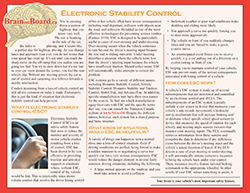Electronic Stability Control (ESC)
Visual rebranding is in progress for these resources.
Lorem ipsum dolor sit amet, consectetur adipiscing elit. Morbi sed finibus metus, ac lobortis ante.
Donec in suscipit augue. Nulla fringilla tempus ante congue tincidunt. Donec ligula nulla, tristique ut turpis quis, congue volutpat enim. Quisque tempor dictum accumsan. Phasellus faucibus blandit magna, vel tincidunt dolor laoreet vitae. Maecenas sodales iaculis libero non efficitur. Ut consequat tempor dolor, vitae interdum diam placerat a. Donec vitae eros id orci dignissim dapibus sed in lacus. Phasellus quis metus sit amet augue vehicula volutpat. Suspendisse sapien quam, convallis nec vestibulum non, sodales a ipsum.
What is electronic stability control (ESC)?
Electronic stability control (ESC) is an active safety feature designed to reduce the number and severity of motor vehicle crashes that result from a loss of control. ESC provides traction and anti-skid support in cases of oversteering and understeering. Over-steering occurs when the vehicle continues to turn beyond the driver’s steering input because the rear end is sliding outwards. Under-steering occurs when the vehicle turns less than the driver’s steering input because the wheels have insufficient traction.
ESC systems go by a variety of different names, including:
- Dynamic Stability Control
- Vehicle Stability Control
- StabiliTrak
- AdvanceTrac
When would ESC be helpful?
ESC allows drivers to retain control of their vehicles in situations where this would otherwise be very difficult or impossible. A common way that drivers lose control is by steering too sharply, which shifts the center of gravity of the vehicle and increases the risk of rolling over. In addition, poor road conditions that make skidding and sliding more likely also increase the risk of oversteering and understeering. ESC reduces the risk of losing control in many fairly common driving situations, including the following:
- An unanticipated event forces you to swerve quickly (e.g., a large animal runs on the road, a car pulls out of a driveway, a cyclist cuts in front of you).
- You approach a curve too quickly and must steer more aggressively.
- One of your wheels hits a patch of ice and as a result your car starts to spin.
How does ESC work?
ESC systems are made up of several subcomponents that are monitored and controlled by an electronic control unit (ECU). The subcomponents include:
- a yaw sensor that measures the vehicle’s side-to-side movement;
- wheel speed sensors that measure the speed of rotation for each wheel;
- a steering angle sensor that monitors your steering input, and;
- a hydraulic unit that increases braking or decreases wheel speed.
The ECU continually retrieves information from these sensors and compiles the data to determine if any difference exists between the driver’s steering input and the vehicle’s actual direction of travel. The wheel speed sensors tell the ECU whether some wheels are spinning more quickly than others, an indication that those wheels are losing traction. If the ECU senses that something is going wrong, it will direct the hydraulic unit to apply more brake force to certain wheels in order to bring the vehicle back under the driver’s control. Some ESC systems also initiate a reduction in engine power.
For example, if the ECU detects a case of oversteering, it will automatically send an order to apply the front outside brake to counter the loss of traction affecting the rear wheels. If understeering occurs, the inside rear brake will be applied to encourage the vehicle to continue to turn in the direction of the driver’s steering input.
How effective is ESC at reducing crashes?
ESC is very effective at reducing the number of severe motor vehicle crashes involving both passenger cars and sport utility vehicles (SUVs):
- ESC reduces fatal single-vehicle crash risk by 49%, and;
- fatal multiple-vehicle crash risk by 20% for both cars and SUVs (IIHS 2011). In addition;
- the risk of being involved in a collision caused by loss of control is estimated to be reduced by 54.5% on cars equipped with ESC and 75.2% on SUVs with ESC (Green and Woodroff 2006).
ESC also helps prevent rollovers. The risk of a fatal passenger car rollover is reduced by 72% with the addition of ESC. For SUVs, ESC reduces the risk of a fatal rollover by 75%.
Crashes that result from a loss of vehicle control can have serious consequences including rollovers, road departure, and collisions with objects on or near the road. Because of its ability to prevent loss of control, ESC is heralded as one of the most effective technologies for preventing fatal crashes (Farmer 2010).
Does ESC have limitations?
Yes. Like make other safety features, fully realizing the benefits of ESC depends largely on whether or not drivers interact appropriately with it. Driver behaviours like speeding, tailgating, fatigued driving, and distracted driving can negate the beneficial aspects of ESC. For example, excessive speed can make it both more likely that drivers will be involved in a situation requiring the assistance of ESC and less likely that ESC will be able to restore complete control. Similarly, since ESC does not steer for drivers, alcohol-impaired drivers may not be able to steer safely, even after ESC has activated. When stabilizing a vehicle, ESC can only use whatever traction is already available on the road – ESC cannot create traction where none exists. As such, drivers are encouraged to take extra precautions when driving on slippery roads or in inclement weather.
ESC does not compensate for unsafe or inattentive driving. It cannot be overstated that in order to ensure the ideal functioning of ESC, drivers must continue to use caution and good judgement behind the wheel.
How many vehicles have ESC now?
Since its introduction in 1995 on luxury vehicles, ESC has quickly gained the attention of road safety professionals and as a result is now standard on many vehicles and optional on many more. Recently, Transport Canada introduced a new Canada Motor Vehicle Safety Standard mandating the installation of ESC on most vehicles manufactured after August 31st, 2011. It is estimated that ESC will be present in 95% of registered vehicles by 2029 (HLDA 2012).
Related Videos
Play Video
Brain on Board – Driving With Mom
Play Video

